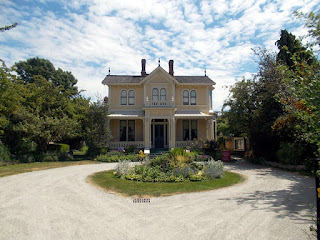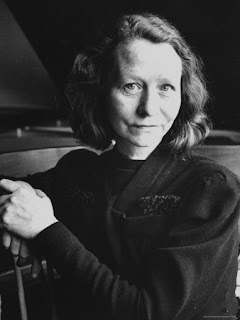Emily Carr's House in Victoria
Emily Carr is one of Canada's most famous artists and her distinctive work was exhibited in England only a few months ago at the Dulwich Art Gallery, called 'Between the Forest and the Sea'. I've been fascinated by Emily ever since a friend lent me the Susan Vreeland novel 'The Forest Lover' based on her life, so one of the things I wanted to do here was to find her home. Emily was born in a newly developing Victoria, in 1871 - the year that British Columbia was incorporated into Canada. Her parents had come from Kent, England, by way of California. Emily's father was a successful businessman who had a store, and built a substantial house on 8 acres of land hacked out of the forest. Emily made fun of his desire to recreate a little England in Canada. 'Father had buried a tremendous homesickness in this new soil and it had rooted and sprung up English'. The house still stands, as elegant as it ever was. It's now a museum dedicated to Emily.
The Carrs were an important part of the city community. The street used to be called Carr St, but is now Government St, because the Parliament building stands on the corner of it.
Emily Carr, the youngest of 5 sisters, was an unusual child. From an early age she refused to conform. She described the moment when her name was inscribed in the family bible with her baby brother's, like this: 'The covers of the Bible banged, shutting us all in.' Her early life was hemmed in by religion. She complained that her sisters were so prudish they had to wear bathing suits when they took a bath and even then, only in a darkened room!
When she was only a young teenager Emily's mother died, probably from tuberculosis, and her father followed 2 years later, leaving Emily under the guardianship of her eldest sister. There was a great deal of friction. Mr Carr had allowed Emily to have art lessons and cherish hopes of a career in art, but now she had to fight for what she wanted, sometimes consulting the family trustee in order to persuade her sisters to let her go to San Francisco, or Paris, or London in pursuit of her studies. There were a lot of arguments in these parlours.
The rooms have been wallpapered with the original designs chosen by the Carr family and are filled with the fussy details of 19th century colonial life. Immigrants even had their pianos shipped the thousands of miles round Cape Horn.
Emily, stifled by the life she was forced to lead in respectable Victoria, became fascinated by First Nation art. She found a couple willing to take her to the remote islands by boat and spent months camping out in order to paint the decaying totem poles, villages and other relics of the culture that was being gradually eroded. It is now a very important record of a vanished world.
But her paintings didn't sell, so Emily spent her inheritance to build a lodging house so that she could live off the rent. It still stands, just round the corner from the Carr house. She hated being a landlady.
Emily gave up painting for 15 years because she was so discouraged. But, after a chance meeting with other artists, she took up her paintbrush again and this time her work was more in tune with the public mood. After an exhibition of Canadian art at the Tate Gallery in London, in 1938, the art critic of the Manchester Guardian described her as 'a genius'.
Her health declined through the late thirties and she developed a heart condition. Advised to take life easily, she began to write and her memoirs and journals are as brilliant as her paintings. I'm currently reading her journals, published after her death in 1945, called 'Hundreds and Thousands'. She once told a would-be biographer 'No one is going to tell my hotch-potch life, but me!'
She died in a nursing home, just along the street from her childhood home. It's now a guest house called the James Bay Inn.
The Carrs were an important part of the city community. The street used to be called Carr St, but is now Government St, because the Parliament building stands on the corner of it.
Emily Carr, the youngest of 5 sisters, was an unusual child. From an early age she refused to conform. She described the moment when her name was inscribed in the family bible with her baby brother's, like this: 'The covers of the Bible banged, shutting us all in.' Her early life was hemmed in by religion. She complained that her sisters were so prudish they had to wear bathing suits when they took a bath and even then, only in a darkened room!
 |
| Emily is wearing the lace collar. |
The rooms have been wallpapered with the original designs chosen by the Carr family and are filled with the fussy details of 19th century colonial life. Immigrants even had their pianos shipped the thousands of miles round Cape Horn.
Emily, stifled by the life she was forced to lead in respectable Victoria, became fascinated by First Nation art. She found a couple willing to take her to the remote islands by boat and spent months camping out in order to paint the decaying totem poles, villages and other relics of the culture that was being gradually eroded. It is now a very important record of a vanished world.
But her paintings didn't sell, so Emily spent her inheritance to build a lodging house so that she could live off the rent. It still stands, just round the corner from the Carr house. She hated being a landlady.
Emily gave up painting for 15 years because she was so discouraged. But, after a chance meeting with other artists, she took up her paintbrush again and this time her work was more in tune with the public mood. After an exhibition of Canadian art at the Tate Gallery in London, in 1938, the art critic of the Manchester Guardian described her as 'a genius'.
Her health declined through the late thirties and she developed a heart condition. Advised to take life easily, she began to write and her memoirs and journals are as brilliant as her paintings. I'm currently reading her journals, published after her death in 1945, called 'Hundreds and Thousands'. She once told a would-be biographer 'No one is going to tell my hotch-potch life, but me!'
 |
| Emily's typewriter and a photograph of her as a child. |










Comments
Post a Comment